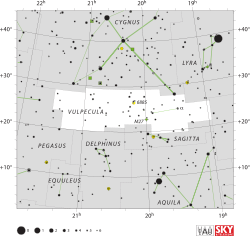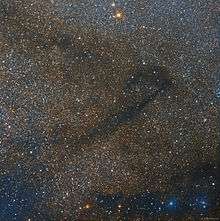Alpha Vulpeculae

| |
| Observation data Epoch J2000.0 Equinox J2000.0 | |
|---|---|
| Constellation | Vulpecula |
| Right ascension | 19h 28m 42.330s[1] |
| Declination | +24° 39′ 53.65″[1] |
| Apparent magnitude (V) | 4.40[2] |
| Characteristics | |
| Spectral type | M1 III[3] |
| B−V color index | 1.487[4] |
| Variable type | +1.81[2] |
| Astrometry | |
| Radial velocity (Rv) | −84.91 ± 0.26[4] km/s |
| Proper motion (μ) | RA: –126.13 ± 0.19[1] mas/yr Dec.: –107.44 ± 0.22[1] mas/yr |
| Parallax (π) | 10.97 ± 0.28[1] mas |
| Distance | 297 ± 8 ly (91 ± 2 pc) |
| Details | |
| Radius | 42[4] R☉ |
| Luminosity | 400[4] L☉ |
| Surface gravity (log g) | 1.5[4] cgs |
| Temperature | 3,990[4] K |
| Rotational velocity (v sin i) | 4.6[4] km/s |
| Other designations | |
| Database references | |
| SIMBAD | data |

Amateur image of LDN 778 (center) and Alpha Vulpeculae, (red giant, top center).
Alpha Vulpeculae (Alpha Vul, α Vulpeculae, α Vul) is the brightest star in the constellation Vulpecula. It has a traditional name, variously represented as Lukida, Lucida Anseris, or Anser, a tradition kept from when the constellation had the name Vulpecula et Anser 'the fox and the goose'.
Alpha Vulpeculae is a red giant of spectral class M1 and has apparent magnitude +4.4. It is approximately 297 light years from Earth. It forms a wide optical binary with 8 Vulpeculae.
It has been analysed as a member of the Arcturus stream, a group of stars with high proper motion and metal-poor properties thought to be the remnants of a small galaxy consumed by the Milky Way.[7]
References
- 1 2 3 4 5 van Leeuwen, F. (2007). "Validation of the new Hipparcos reduction". Astronomy and Astrophysics. 474 (2): 653–664. arXiv:0708.1752
 . Bibcode:2007A&A...474..653V. doi:10.1051/0004-6361:20078357.Vizier catalog entry
. Bibcode:2007A&A...474..653V. doi:10.1051/0004-6361:20078357.Vizier catalog entry - 1 2 Mermilliod, J.-C. (1986), "Compilation of Eggen's UBV data, transformed to UBV (unpublished)", Catalogue of Eggen's UBV data. SIMBAD, Bibcode:1986EgUBV........0M.
- ↑ Morgan, W. W.; Keenan, P. C. (1973), "Spectral Classification", Annual Review of Astronomy and Astrophysics, 11: 29, Bibcode:1973ARA&A..11...29M, doi:10.1146/annurev.aa.11.090173.000333.
- 1 2 3 4 5 6 7 Massarotti, Alessandro; et al. (January 2008), "Rotational and radial velocities for a sample of 761 HIPPARCOS giants and the role of binarity", The Astronomical Journal, 135 (1): 209–231, Bibcode:2008AJ....135..209M, doi:10.1088/0004-6256/135/1/209.
- ↑ Barentine, John C. (2016). "Anser". The Lost Constellations. p. 35. doi:10.1007/978-3-319-22795-5_3. ISBN 978-3-319-22794-8.
- ↑ "HD 20781 -- High proper-motion Star". SIMBAD Astronomical Database. Centre de données astronomiques de Strasbourg. Retrieved 2014-09-13.
- ↑ Eggen, Olin (1971). "The Arcturus Group". Publications of the Astronomical Society of the Pacific. 83 (493): 271–85. Bibcode:1971PASP...83..271E. doi:10.1086/129120.
This article is issued from Wikipedia - version of the 4/22/2016. The text is available under the Creative Commons Attribution/Share Alike but additional terms may apply for the media files.